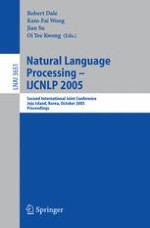2005 | Buch
Natural Language Processing – IJCNLP 2005
Second International Joint Conference, Jeju Island, Korea, October 11-13, 2005. Proceedings
herausgegeben von: Robert Dale, Kam-Fai Wong, Jian Su, Oi Yee Kwong
Verlag: Springer Berlin Heidelberg
Buchreihe : Lecture Notes in Computer Science
